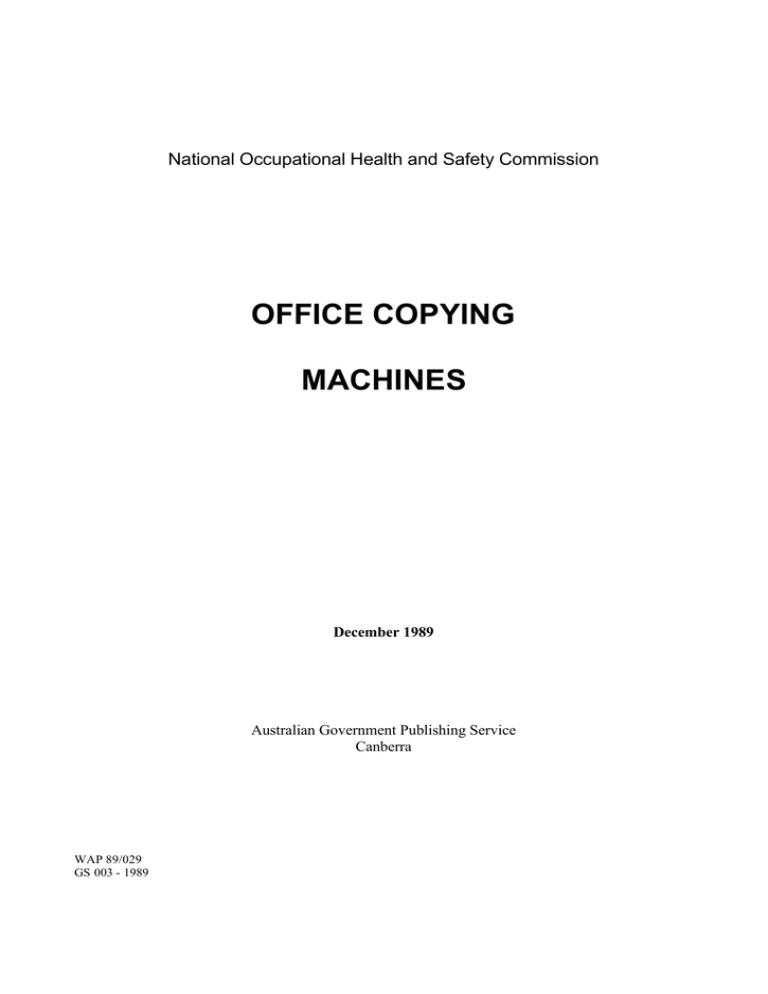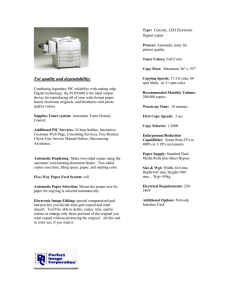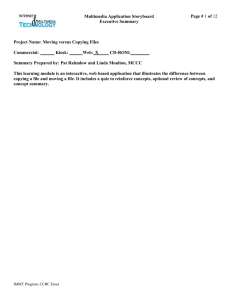office copying machines
advertisement

National Occupational Health and Safety Commission OFFICE COPYING MACHINES December 1989 Australian Government Publishing Service Canberra WAP 89/029 GS 003 - 1989 © Commonwealth of Australia 1989 ISBN 0 644 09189 4 This work is copyright. Apart from any use as permitted under the Copyright Act 1968, no part may be reproduced by any process without written permission from the Director Publishing and Marketing, AGPS. Inquiries should be directed to the Manage r, AGPS Press, Australian Government Publishing Service, GPO Box 84, Canberra ACT 2601. The National Commission's address is: National Occupational Health and Safety Commission Level 30, St Martins Tower 31 Market Street Sydney NSW 2000 GPO Box 58 Sydney NSW 2001 Tel: (02) 265 7555 Facsimile: (02) 265 7538 Telex: 177243 Printed in Australia by Alken Press, Smithfield. Foreword_______________________________________ The National Occupational Health and Safety Commission, Worksafe Australia, is a tripartite body established by the Commonwealth Government to develop, facilitate and implement a national approach to occupational health and safety. The National Commission comprises representatives of the peak employee and employer bodies the Australian Council of Trade Unions (ACTU) and Confederation of Australian Industry (CAI) as well as the Commonwealth, State and Territory governments. Since its establishment, the National Commission has produced occupational health guides. Before the National Commission was established, a series of similar guides was published by the National Health and Medical Research Council. This Guide has been reviewed and endorsed by a working group of the National Commission as part of the co-ordinated effort by the Commonwealth, State and Territory governments and employee and employer organisations to make Australian workplaces safe and healthy. Although this Guide has been endorsed by the National Commission, it is an advisory document only. It is produced and distributed in the interests of providing useful information on occupational health and safety for employers, employees and others. This document does not replace statutory requirements under relevant State and Territory legislation. This Guide is aimed primarily at workers and managers but should also be useful to occupational health and safety personnel and others. It may be used in conjunction with appropriate training and consultation, in line with good management practice. iii Contents________________________________________ Foreword iii Introduction 1 Identification 2 Health Hazards 4 Prevention and Control Measures 7 Further Reading 11 v Introduction_____________________________________ This Guide outlines some potential health hazards associated with the operation of office copying machines. The use of copying equipment is widespread, and some employees may be engaged in their operation on a full- time basis. Copying machines may normally be operated without any detrimental effects on health if the general principles outlined in this Guide are followed. However, discomfort or health effects may arise if machines are poorly sited, inadequately ventilated, poorly maintained or used by operators for long periods continuously. This Guide should be read in conjunction with the Worksafe Australia Guide, Atmospheric Contaminants, and the National Commission publication, Exposure Standards for Atmospheric Contaminants in the Occupational Environment (latest edition). Office copying machines 1 Identification Copying equipment and processes A wide variety of copying machines, including photocopiers, laser printers, facsimile machines, diazo printers and spirit duplicators, are used in offices. Several processes are involved. The electrostatic process is used in all photocopiers. Light is reflected from the original documents so that an image is projected on to an electrically-charged drum or belt. The surface of the drum is photoconductive, that is, it loses the electrostatic charge when exposed to light. In this way, reflected light leaves a pattern of charges on the photoconductive surface which corresponds to the dark print of the original. This remaining charge attracts a special toner chemical. In ‘dry’ copiers the toner (carbon black plus a resin) is mixed with a carrier material (small steel, glass, or silica beads) in powder form. The carrier is recycled when the toner clings to the pattern on the drum. ‘Wet’ copiers use a hydrocarbon liquid, usually isodecane, to transfer the toner to the drum or belt. The final step in the process is the transfer of toner to the copy paper. Heat or pressure are used in dry copiers to achieve this, in conjunction with the electrical discharge of the drum or belt. In wet copiers the paper is moistened with isodecane prior to toner transfer and heat and/or air currents are used to dry the paper after transfer of the image. An older, less common form of the electrostatic process utilises copy paper treated with zinc oxide as the photoconductor. Some microfiche and microfilm readers have an in-built photocopying facility. Colour copiers use the same basic electrostatic process, but have three toner systems, incorporating the primary colours green, red and blue. The copy paper passes through each toner system in turn. Laser printers take digitised (electronic) signals, translate them via a laser beam to a light-sensitive surface, and a copy is then made from the image produced, in the same way as a photocopier. Office copying machines 2 Facsimile (fax) equipment also operates from digital input signals, which are decoded on to copy paper as it moves across a heated surface. The copy paper is usually chemically treated. Alternatively, heat-sensitive ribbon is used with plain paper. The diazo process is often utilised in plan printing machines. Chemically-sensitised paper is exposed to an image and subsequently developed using ammonia vapour, chemical solutions or heat. The process is so named because reddish-brown diazo dyes may be used. Spirit duplicators utilise a wet process, with a volatile solution such as methylated spirits used to facilitate the transfer of dye to the copy paper via a stencil image. The spirit evaporates from the copy after printing. Office copying machines 3 Health Hazards When considering the hazards associated with any workplace, it is essential to understand the relationship between ‘hazard’, ‘exposure’ and ‘risk’. ‘Hazard’ is the potential for an agent or process to do harm. ‘Risk’ is the likelihood that an agent will produce injury or disease under specified conditions. Health effects can only occur if a worker is actually exposed to the hazard. The risk of injury or disease usually increases with the duration and frequency of exposure to the agent, and the intensity/concentration and toxicity of the agent. Toxicity refers to the capacity of an agent to produce disease or injury. The evaluation of toxicity takes into account the route of exposure and the actual concentration of an agent in the body. The processes outlined above may result in the release of particles, vapours and gases to the environment. These agents may be hazardous if they are present in concentrations above the exposure standards. Ozone Electrostatic photocopiers produce small amounts of ozone (O 3 - an unstable form of oxygen). Ozone is also produced naturally in the upper atmosphere by ultraviolet solar radiation. If present in sufficient concentration, this odorous gas is irritating to the eyes, the lungs, throat and nasal passages. Ozone is normally detected by smell at concentrations of 0.01 to 0.02 parts per million (ppm). Symptoms may occur at levels of approximately 0.25 ppm or above. The exposure standard for ozone is currently 0.1 ppm, averaged over an eight- hour period. The National Commission publication, Exposure Standards for Atmospheric Contaminants in the Occupational Environment (latest edition), should be consulted for further information on exposure standards. The concentration of ozone within the breathing zone of the operator is dependent on the amount of ozone discharged from the copier, the rate of decay of the ozone, the volume of air in the room, the concentration of ozone in any intake air and the ventilation provided in the room. Office copying machines 4 The majority of the ozone is produced during the charging and discharging of the drum and paper. Machines which utilise a negative DC process, with the electrostatic drum carrying a negative charge, produce the greatest amount of ozone. Some ozone is produced by ultraviolet emission from the photocopier lamp. Under normal circumstances, the concentration of ozone around photocopiers is not sufficient to cause symptoms. Ozone is readily decomposed back to oxygen. The rate of decomposition is dependent on time, temperature (the gas breaks down much more rapidly at a high temperature) and contact with various surfaces. Activated carbon will provide 100 per cent decomposition given sufficient contact with ozone. Many photocopiers have activated carbon filters fitted to decompose ozone. Selenium and cadmium The photoconductive material in photocopiers is usually selenium. Cadmium sulphide, zinc oxide and organic polymers are also used. Trace amounts of these materials can become airborne. However, investigations have shown that under normal operating conditions the resultant concentrations of these pollutants are well below those concentrations associated with health effects. Toner materials Toners contain carbon black. In the past, potential health effects associated with carbon black have been linked to the presence of impurities. Pure carbon black has not been associated with adverse health effects. As currently manufactured, carbon blacks contain extremely low levels of impurities and do not warrant concern regarding health effects. Toner dust may irritate the respiratory tract, resulting in coughing and sneezing. The fine toner powder used in dry photocopying can be released from copiers, particularly if they lack containerised toner systems and automatic shut-down devices on waste toner compartments. Physical factors Possible discomfort from the light, heat and noise generated by office copying machines should be considered. Fluorescent, metal halide or qua rtz exposure lamps are most commonly used in photocopiers. Eye damage has not been shown to be caused by photocopier operation. Ultraviolet light does not pass through the document glass. Discomfort from the intensity of light may be avoided by closing the Office copying machines 5 document cover or using the automatic document feeder. Burns from hot components may occur during operations such as clearing paper misfeeds. Heat generated by photocopiers can be a source of discomfort. The noise of a copying machine in operation may be a nuisance to nearby workers. Musculoskeletal discomfort may arise from continuous photocopying, collating copies and attention to equipment. Sustained and repetitive postures may lead to muscular fatigue. Solvents In low concentrations, solvent vapours from wet copiers may create an odour problem, particularly if ventilation is poor. In higher concentrations, effects on health may occur. Vapour from spirit duplicators and wet photocopiers can easily become concentrated in poorly ventilated rooms and this can result in symptoms such as headache and poor concentration. Irritation to the eyes, skin and respiratory tract can result from exposure to solvent vapours in wet processes. Agents such as ammonia (diazo process), industrial methylated spirits (spirit duplicators), isodecane (wet photocopiers), cyclohexane and formaldehyde may be involved. Material safety data sheets (MSDS) should be consulted for specific toxicity information. Dermatitis Contact dermatitis may occur from the handling of chemically- treated paper and chemicals used in some wet processes such as diazo. Office copying machines 6 Prevention and Control Measures To establish appropriate prevention of significant health effects, an evaluation of work practices and conditions must be undertaken by qualified health and safety personnel. These practices should be considered an integral part of management. Good occupational hygiene promotes elimination of hazards, where practicable. Engineering controls to minimise hazards at their source, where practicable, and administrative controls should be adopted. The majority of the hazards outlined above can be satisfactorily controlled by ensuring adequate ventilation in the room and around the equipment, applying ergonomic design principles, correctly maintaining machines and exercising caution in the handling of chemicals. Potentially irritating or harmful concentrations of the various airborne contaminants are most likely to exist when a small room is used for copying, the number of air changes in the room is low and the office copying equipment is extensively used. Note: Ergonomics is the study of the relationship between people and their work environments. The objective of this study is to make the best use of human capabilities without exceeding human limitations. The following guidelines should be adopted to prevent any undesirable effects resulting from the use of office copying equipment. Design of equipment and workplace The copying machine selected, the workplace design and the work schedule should be such that they allow operators and maintenance personnel to work without risk of musculoskeletal discomfort. That is, the positioning and height of various components should be such that sustained and repetitive postures are avoided. Photocopying and collating should form only a part of a person's duties, and should not be carried out continuously for long periods. Automatic collators and electric stapling machines are recommended if a significant amount of collating is necessary. Provide adequate ventilation All copying equipment should be located in well ventilated areas. Where this requires mechanical ventilation, it should conform to Australian Standard AS 1668. Diazo copiers and other wet Office copying machines 7 copying equipment require special consideration, particularly if they are in heavy or continuous use. Rooms used for the drying of prints from wet processes should be well- ventilated. The exhaust air from copy processes should be ducted directly to the external atmosphere, not added to the general ventilation system. Photocopiers should be installed according to the manufacturer's instructions, with sufficient space and airflow around the machines. Air movement in copying areas should be monitored regularly. Solvents and toners Whenever volatile fluids (toners, ammonia, methylated spirits) are being introduced to machines, skin contact and inhalation of vapours and dusts should be avoided. Adequate ventilation should be provided. Personal protective equipment should be available and used, and correct storage procedures followed, in accordance with MSDS information. Protective gloves should be used when cleaning up and disposing of spilt fluids or spent toner. Such material should be placed in sealed plastic bags marked ‘chemical waste’. Photocopiers which utilise containerised toner- filling systems and activate automatic shut-down devices when toner waste compartments are full are recommended. Toner wastes should be emptied regularly. MSDS on any chemicals involved should be obtained from the supplier or service contractor, and be readily available for perusal by all. Ozone Concentrations of ozone in copy rooms should remain within acceptable levels if the photocopier is serviced regularly, is fitted with a good quality ozone filter, is provided with adequate ventilation and is operated in accordance with the manufacturer's specifications. However, a combination of heavy use, poor maintenance and inadequate ventilation can result in excessive ozone levels. This may signal the need for assessment and recommendation of control measures by an appropriately qualified person. Note: Some copiers, particularly older ones, may not have ozone filters. Office copying machines 8 Noise Noise produced by office copying machines should be minimised as far as practicable. Where necessary, an evaluation by an appropriately qualified person may be undertaken. Replacing noisy machines, surrounding them with absorbent panels, providing they do not interfere with airflow and using special materials in the walls and ceilings of the room are some possible control measures. Maintain the equipment Arrangements should be made to ensure that machines are cleaned and maintained regularly. A maintenance log should be kept for each machine and should be ava ilable to staff for inspection. Staff should be appropriately trained for their particular involvement, for example: • a general operator - training in the correct operation of machines; and • a person who co-ordinates the servicing of machines - training in the correct handling and storage of all chemicals, the introduction of chemicals to copiers and the disposal of wastes. A trained technical service operator should maintain the equipment. The diagram and the following checklist illustrate the principles to adopt in order to provide and maintain a healthy working environment in the vicinity of office copying equipment. Office copying machines 9 Checklist for the Safe Use of Office Copying Machines: 1. Equipment should be installed in an adequately ventilated area to facilitate safe removal of any dusts, gases or vapours. 2. If installed in an enclosed room, mechanical ventilation may be required (refer to Australian Standard AS 1668). 3. There should be adequate space around copiers, to allow for good airflow and to facilitate maintenance. 4. Equipment should be regularly maintained. 5. The working surface of the copier should be at a comfortable height for the operator. 6. Where necessary, a collating table, at a comfortable working height, should be provided. 7. For any chemicals used, MSDS should be available. Office copying machines 10 Further Reading Commonwealth Department of Science and Technology, Clean Air at Work, Australian Government Publishing Service, Canberra, 1981. Halton, D., Photocopiers - Do they pose a health hazard?, Canadian Centre for Occupational Health and Safety, Hamilton, Ontario, 1983. Hansen, T.B. and Andersen, B., ‘Ozone and other air pollutants from photocopying machines’, American Industrial Hygiene Association Journal, vol. 47, no. 10, pp. 659-65, 1986. Marks, J.G., ‘Allergic contact dermatitis from carbonless copy paper’, Journal of the American Medical Association, vol. 245, pp. 2331-332, 1981. National Institute of Occupational Safety and Health, Report TA 80-32, National Institute of Occupational Safety and Health, Cincinnati, 1980. Standards Australia, AS 1668-1980 Part 2 Ventilation Requirements, Sydney. Office copying machines 11

